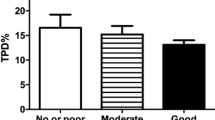Abstract
The techniques currently used to assess myocardial infarction are limited in their ability to determine the amount of viable myocardium after a temporary ischemic event. Blood flow and segmental function may not necessarily demonstrate salvage, whereas metabolic parameters will determine cell survival. In an open chest dog model, short occlusion times of 20 min and subsequent reperfusion using C-11 palmitate as an index of fatty acid metabolism showed depression of fatty acid oxidation, which recovered after 3 hours of reperfusion, indicating the partial reversibility of the ischemic condition. In more extensive studies, using positron emission tomography (PET) and, as an indicator of glucose metabolism, fluoro-F-18-deoxyglucose (FDG); N-13 ammonia in addition to C-11 palmitate for the determination of blood flow; and ultrasonic crystals to measure shortening in the reperfused and control territories, the duration of occlusion was 3 h. Metabolic studies were repeated 24 h, 1 week, and 4 weeks after the ischemic injury. Reperfused viable myocardium exhibited residual glucose metabolism with FDG, whereas fatty acid oxidation remained impaired for a longer period. Gradual metabolic recovery during a 4-week period was associated with the prolonged recovery of regional function, whereas a lack of residual metabolic activity indicated that little change in function was likely to occur. Increased FDG uptake and impaired C-11 palmitate turnover are characteristic of reversibly injured tissue. Therefore, PET studies may offer a unique potential for the evaluation of therapeutic measures such as thrombolysis and early revascularization.
Similar content being viewed by others
References
Braunwald E, Kloner RA (1983) The stunned myocardium: prolonged, postischemic ventricular dysfunction. Circulation 66:1146
Geltman EM, Biello D, Welch MJ, Ter-Pogossian MM, Sobel EE (1981) Characterization of nontransmural myocardial infarction by positron emission tomography. Circulation 65:747
Kloner RA, DeBoer LW, Darsce JR, Ingwall JS, Hale S, Tumas J, Braunwald E (1981) Prolonged abnormalities of myocardium salvaged by reperfusion. Am J Physiol 241:H591
Lerch RA, Bergmann SR, Ambos HD, Welch MJ, Ter-Pogossian M, Sobel BE (1982) Effect of flow-dependent reduction of metabolism on regional myocardial clearance of 11C-palmitate. Circulation 65:731–738
Liedtke AJ (1981) Alterations of carbohydrate and lipid metabolism in the acutely ischemic heart. Prog Cardiovasc Dis 23:321
Marshall RC, Tillisch JH, Phelps ME, Huang SC, Carson R, Henze E, Schelbert HR (1981) Identification and differentiation of resting myocardial ischemia and infarction in man with poritron computed tomography, 18F-labeled fluorodeoxyglucose and N-13 ammonia. Circulation 67:766–778
Reimer KA, Lowe JE, Rasmussen MM, Jennings RB (1977) The wavefront phenomenon of ischemic cell death. I. Myocardial infarct size vs duration of coronary occlusion in dogs. Circulation 56:786–794
Reimer KA, Hill ML, Hennings RB (1981) Prolonged depletion of ATP and of the nucleotide pool due to delayed resynthesis of adenine nucleotides following reversible ischemic injury in dogs. J Mol Cell Cardiol 3:229
Schelbert HR, Phelps ME, Huang SC, MacDonald NS, Hansen H, Selin C, Kuhl DE (1981) N-13 ammonia as an indicator of myocardial blood flow. Circulation 63:1259
Schelbert HR, Phelps ME, Shine KI (1983a) Imaging metabolism and biochemistry—a new look at the heart. Am Heart J 105:522
Schelbert HR, Henze E, Schon HR, Najafi A, Hansen H, Huang SC, Barrio JR, Phelps ME (1983b) C-11 palmitic acid for the noninvasive evaluation of regional myocardial fatty acid metabolism with positron computed tomography. IV. In vivo demonstration of impaired fatty acid oxidation in acute myocardial ischemia. AM Heart J 106:736
Schon HR, Schelbert HR, Najafi A, Hansen H, Huang H, Barrio J, Phelps ME (1982) C-11 labeled palmitic acid for the noninvasive evaluation of regional myocardial fatty acid metabolism with positron computed tomography. II. Kinetics of C-11 palmitic acid in acutely ischemic myocardium. Am Heart J 103:548
Schwaiger M, Hansen HW, Sochor H, Parodi O, Yeatman LA, Ellison DJ, Selin C, Grover M, Schelbert HR (1984) Delayed recovery of regional glucose metabolism in reperfused canine myocardium by Positron-CT. J Am Coll Cardiol 3:552
Schwaiger M, Schelbert HR, Keen R, Vinten-Johansen J, Hansen H, Selin C, Barrio J, Huang SC, Phelps ME (1985a) Retention and clearance of C-11 palmitic acid in ischemic and reperfused canine myocardium. J Am Coll Cardiol 6:311–320
Schwaiger M, Schelbert HR, Ellison D, Hansen H, Yeatman L, Vinten-Johansen J, Selin C, Barrio J, Phelps ME (1985b) Sustained regional abnormalities in cardiac metabolism after transient ischemia in the chronic dog model. J Am Coll Cardiol 6:336–347
Sochor H, Schwaiger M, Schelbert HR, Ellison D, Hansen H, Selin C, Grover M, Huang SC (1985) Assessment of tissue viability in reperfused canine myocardium by a multiple radiotracer technique. J Am Coll Cardiol 5:451
Wood JM, Hanley HG, Entman ML, Hartley CJ, Swain JA, Busch U, Chang CH, Lewis RM, Morgan WJ, Schwartz A (1979) Biochemical and morphological correlates of acute experimental myocardial ischemia in the dog. IV. Energy mechanisms during very early ischemia. Circ Res 44:52–61
Author information
Authors and Affiliations
Additional information
Operated for the US Department of Energy by the University of California under contract no. DE-AC03-76-SF00012. This work was supported in part by the Director of the Office of Energy Research, Office of Health and Environmental Research, by NIH grant nos. HL 29845 and HL 33177, and by an Investigatorship Group Award by the Greater Los Angeles Affiliate of the American Heart Association
Rights and permissions
About this article
Cite this article
Schwaiger, M. Time course of metabolic findings in coronary occlusion and reperfusion and their role for assessing myocardial salvage. Eur J Nucl Med 12 (Suppl 1), S54–S58 (1986). https://doi.org/10.1007/BF00258107
Issue Date:
DOI: https://doi.org/10.1007/BF00258107




